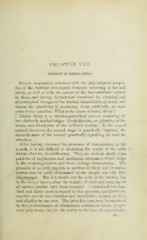Page 233 - My FlipBook
P. 233
CHAPTER VIII \
ETIOLOGY OF DENTAL DECAY,
Having acquainted ourselves with the physiological proper-
ties of the chemical and organic ferments occurring in the oral
cavity, as well as with the nature of the fermentations excited
by them, and having furthermore examined the chemical and
microscopical changes of the dentine characteristic of decay, and
shown the possibility of producing decay artificially, we now
come to the question What is the cause of dental decay ?
:
r Dental decay is a chemico-parasitical process consisting of
two distinctly marked stages : decalcification, or softening of the
tissue, and dissolution of the softened residue. In the case of •
enamel, however, the second stage is practically wanting, the
decalcification of the enamel practically signitH'ing its total de-
struction.
After having discussed the processes of fermentation in the
mouth, it is not diffi.cult to determine the source of the acids —
which eiiect the decalcification. They are derived chiefly Irom
particles of amylaceous and saccharine substances which lodge
in the retaining-centers and there undergo fermentation. The
presence of an acid^_reaction in cavities of decay an
centers may be easily determined by the simple test with blue
litmus-paper. The test should not be made at the surtace, but
in the deeper layers, after the remains of food and outer layers
of carious dentine have been removed. I examined two hun-
dred and thirty cases in regard to this question, and found the
reaction acid in two hundred and twenty-five, neutral in four,
and alkaline in one case. The latter five cases may be explained
by the predominance of albuminous substances (meat, gangre-
nous pulp-tissue, etc.) in the cavity at the time of examination.
20.J


